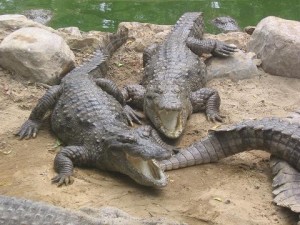Scientists have discovered an aggressive “man eating” crocodile in Florida. The first hatchling was first found on a householder’s porch near Miami in 2009, but the results of DNA testing have only been announced. The second crocodile found was a small female discovered two years later at a Fruit & Spice Park in Homestead, Florida. The third was a male and was caught in a canal in 2014.
Scientists at the University of Florida analyzed the DNA of three reptiles pulled out of the Everglades swamp which confirmed that they are Nile crocodiles. They are second largest species in the world and can grow up to 16 feet in length. They are also man eaters, and according to researchers, they kill up to 200 people a year.
Scientists are still trying to solve the mystery how they arrived in Florida.
“They didn’t swim from Africa,” said Kenneth Krysko, herpetology collections manager at the Florida Museum of Natural History at the University of Florida.
Chances are they were imported illegally and probably there are more such crocodiles in Florida.
“My hope as a biologist is that the introduction of Nile crocodiles in Florida opens everyone’s eyes to the problem of invasive species that we have here in our state,” Mr Krysko said.
“The odds that the few of us who study Florida reptiles have found all of the Nile crocs out there is probably unlikely,” said Krysko.
Robert Klepper, a spokesman for the Florida Wildlife Conservation Commission said: “There are no other confirmed sightings of Nile crocodiles in the wild in Florida and no captive animals that are unaccounted for.”
According to Klepper, regular surveys are done “along many of South Florida’s levee systems to detect these and other exotic species.” He revealed that no wild crocodiles have been spotted in the past two years, and that these crocodiles had escaped from Predator World.
“We’re confident this won’t be a problem,” he said.
Klepper thinks “it is unlikely” that they mated with native Florida alligators during their years in the wild.
“We are unaware of any successful hybridization between Nile and American Crocs.”
“It is highly improbable that this croc would mate with the wild native crocodile because of dissimilar habitat and behavior.”
“My hope as a biologist is that the introduction of Nile crocodiles in Florida opens everyone’s eyes to the problem of invasive species that we have here in our state,” Krysko said.

